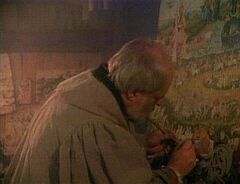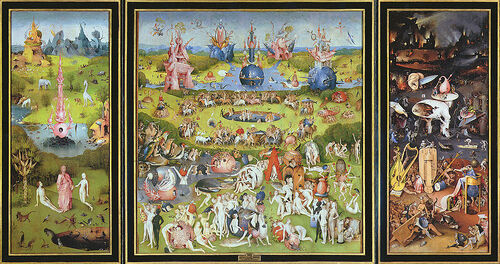
Hieronymous Bosch at work on The Garden of Earthly Delights in "Dead Issue".
The Garden of Earthly Delights is a painting by the Dutch artist Hieronymous Bosch, painted 1503-04. In the flashback to the episode, "Dead Issue", Nicholas de Brabant is one of the models whom Bosch used when painting the central picture of the triptych. At the same time, the artist is also employing a female model, Ilsa, with whom Nicholas becomes quite friendly. She confides to him that Bosch had raped her. For this she blames herself, insisting to Nicholas that it was her inherent lustfulness that prompted Bosch's crime. She later committs suicide.
Just as Bosch was an historical figure written into the flashback, so the painting on which he is seen working is actually one of Bosch's works. However, it is obviously a copy or print of The Garden of Earthly Delights that was used during filming the scene in Bosch's studio.
The Garden of Earthly Delights[]
The masterpiece reveals the artist at the height of his powers; in no other painting does Bosch achieve such complexity of meaning or such vivid imagery. It depicts several biblical scenes on a grand scale, and was probably intended to illustrate the history of mankind according to medieval Christian doctrine.
The Garden of Earthly Delights is a triptych. In other words, it has three panels: a large one in the centre, which depicts the main subject, flanked by two smaller ones. The paintings are, however, intended to be read sequentially, left to right, to show the overall meaning. The outer panels are hinged; and the whole thing can be closed up to show another painting on the exterior.
The lefthand panel depicts Eden, where God presents to Adam the newly created Eve. However, God is absent from the central panel, which shows humanity acting with free will, engaging in various sexual activities in a broad panorama of nude figures, fantastical animals, and oversized fruit. The righthand panel, which is a hellscape showing the fantastic torments meted out to the damned, is believed to show God's vengeance for the sins depicted in the central panel.

The exterior panels, when closed like shutters, reveal a picture of God creating the Earth.
When the exterior panels are closed, there is the fourth picture: God creating the Earth. It is rendered in a green–gray grisaille. This was a common practice with outer panels of Netherlandish altarpieces, and done so that the blandness would highlight the splendid colour inside. The exterior panels show the world during creation, probably on the third day, after the addition of plant life but before the appearance of humanity. God is visible as a tiny figure at the upper left.
These paintings have a rough surface from the application of paint; this contrasts with the traditional Flemish style of paintings, where the smooth surface attempts to hide the fact that the painting is man-made.
It is not known whether The Garden of Earthly Delights was intended as an altarpiece; but the general critical view is that the extreme subject matter of the centre and right panels makes it unlikely that the painting was intended to function in a church or monastery, but was instead commissioned by a lay patron. It is thought probable that this patron was Henry III of Nassau-Breda, the Stadtholder (governor) of several of the Habsburg provinces in the Low Countries.
Interpretation of the Painting[]
Bosch's work is generally described as a warning against lust, and the central panel as a representation of the transience of worldly pleasure. The painting is thus a sequential narrative that depicts mankind's initial state of innocence in Eden, followed by the subsequent corruption of that innocence after the creation of Eve, and finally the punishment in Hell of the various Deadly Sins, especially lust. At various times in its history, the triptych has been known as The Sins of the World and The Wages of Sin.
Proponents of this idea point out that moralists during Bosch's era believed that it was woman's—ultimately Eve's—temptation that drew men into a life of lechery and sin. This would explain why the women in the centre panel are very much among the active participants in bringing about the fall. At the time, the power of femininity was often rendered by showing a female surrounded by a circle of males.
- Adapted from the Wikipedia article on The Garden of Earthly Delights.
